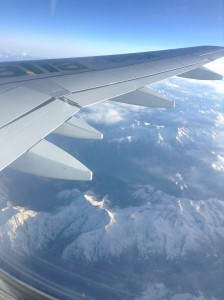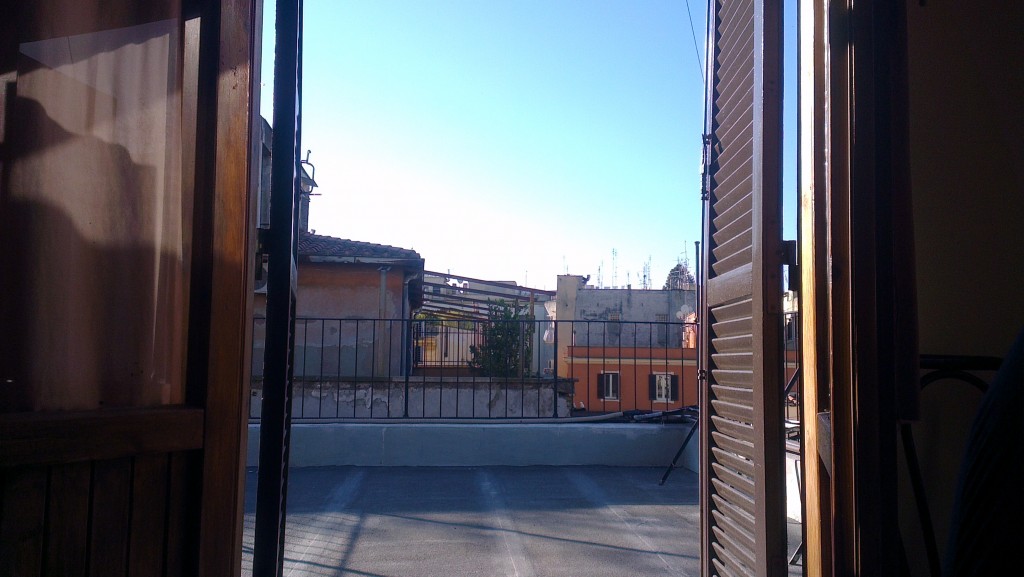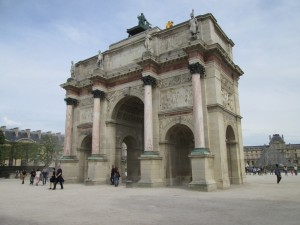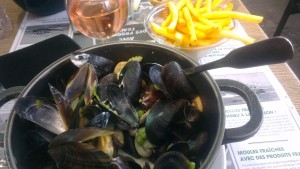It was a Wednesday evening when I found myself, around 10pm, after a great multi-course Italian dinner, sipping red wine beside a fountain in a square in Rome. I think I’m still trying to get my head around the idea.
I was in Rome for meetings, which took up most of the time I was there – a little sadly, as the days we sat in the meeting room were gloriously sunny. By Friday afternoon, however, we were done and, after the best spaghetti carbonara ever, a few of us headed off to do some walking.
It was great to be exploring with others. Instead of concentrating on where I was going, I could relax and follow someone else’s lead. We headed first, taking the Metro (which is worse than the one in Paris), towards the Vatican. From the Metro stop, we walked along a little road until we reached the imposing Vatican wall. One of the people I was with was determined to stop at what she had been told was the best Gelato shop (Gelateria) in Rome. Nutella Gelato. Try it. Seriously.
And then to the Vatican. With such an incredibly short time to see all of Rome (a day and a half), there was not time to go into places like the Vatican Museum. Instead, the plan was to wander around and simply look at things. I couldn’t have been happier. We entered Piazza San Pietro. The queues for the museum snaked around the corner. The fountains sparkled gloriously in the afternoon sun. Chairs had been set up beside the obelisk, ready for the Palm Sunday service. Around the edges, saints looked down from above the many, many pillars. Like so much of Rome, it is difficult to describe the grandeur and sense of history and amazement. It almost seems silly to try to put a description into words.
We walked on, heading, without any particular intention towards the Castel Sant’Angelo, a magnificent building surrounded by plenty of statues of angels. It is also known as the Mausoleum of Hadrian and was constructed at the commission of Roman Emperor Hadrian on the right bank of the Tiber River between 130 and 139 AD.
My knowledge of Roman history is extremely limited, my studies having focused on modern history rather than classics. Yet the name Tiber has a particular resonance thanks to a book by my favourite author, Ursula Le Guin. The book is called Lavinia. It is set in Italy before Rome was Rome and it brings to life the voice of a girl mentioned only as the king’s daughter in The Aeneid. It’s a beautifully written book and Le Guin’s attention to detail creates a wonderfully eerie sense of this river flowing through time.
We passed on past sellers of books and curios and past what we thought probably wasn’t the Museo delle Anime del Purgatorio, which it seemed to be from one of our guidebooks. This macabre museum apparently contains a collection of “hand- and fingerprints left on prayer books and clothes of the living by dead loved ones, to request masses to release their souls from purgatory”. Actually – now that I’ve done a little more research, we were looking at the detailed, ornate and very impressive Palace of Justice.
Across a bridge and a stroll away from the river, we found ourselves in side-alleys, lined with tiny shops and bars and restaurants and set between tall, old buildings. Boutiques neighboured book stores and bars (my favourite called “Draft Book”). Down a side alley, a little restaurant sat beside an art shop, with paintings hanging and standing on the sidewalk. Scooters and cars and bicycles eased their way along the streets, forcing us to hug the walls. The colours and the shops and the building shapes fitted so perfectly to the winding alleys were so clearly what all those “Italian-style housing” developers are trying so miserably to copy, what Monte Casino would be like if it wasn’t fake and gaudy.
The bright sunlight was beginning to fade and one of our group headed back to her lodgings in Trastevere. We considered going that way but instead decided to wind a slow gentle path past several major tourist attractions before heading back down towards our hotel near the Colosseo (Coliseum).
Our first stop was the Piazza Navona. This piazza has two great fountains, one of which is Bernini’s Fountain of Four Rivers. Both have incredible detail and if, like me, you’re a sucker for fountains, this will take your breath away. The piazza wasn’t quiet. A group of musicians was setting to perform. An Indian man (perhaps a holy man, perhaps a con-man) was floating in the air above his mat, with a thick stick in in one hand. A young man was using spray paint and fire to create art (which appeared less dangerous than it sounds). A comedian or magician was entertaining a crowd. At a desk, an artist sat sketching with intense concentration. We eased our way through the crowds and moved on.
We reached the Parthenon as the sun was beginning to slide towards the horizon. This incredible spot had been recommended to me by friends who visited Rome last year. It is incredible. From the soaring pillars around the entrance to the domed and decorated ceiling and the stunning marble floors, the building itself is impressive. In addition, the historical artefacts, the sacred statues, the alter and the tombs need far more time than we had to enjoy. Unfortunately, perhaps particularly at this time of day, there were many people there, most of them, sadly, talking at the top of their voices (in spite of the signs and the regularly repeated announcements requesting silence) and taking happy-snaps of themselves in awkward positions that made it difficult to look at anything without stepping into a photograph. Still, it was fantastic and if I ever return to Rome, this will be the first spot I visit.
We worked our way through the crowds, narrowly avoiding the “roman soldiers” offering horse-and-cart rides and pictures in costume. Not far from the Pantheon, we entered a little square and found two people creating giant bubbles that floated across the square and burst on a wall of giant columns cemented into the side of a building. From there we wandered on, past official-looking buildings until we came to another square and another famous fountain.
Trevi Fountain is a staple of Rome and certainly popular – the crowds here were even heavier than at the previous spots. The fountain itself is gorgeous. The water so blue, the design so beautiful and everyone finding a chance to throw a coin in the fountain guaranteeing, according to legend, that they will one day return to Rome.
From Trevi Fountain, we turned north and walked through some more up-market, clearly trendy areas. The sun had still not completely set when we reached the Spanish Steps. The guidebook we were using seemed to suggest that the construction of the steps was a (successful) attempt to stop the French and the Spanish from fighting each other. It remains unclear how. It also contained the more useful information that the steps should more accurately be called the French steps as they were paid for by a French diplomat who objected to the muddy slope that led up to the church that had been built with money from a French king. To the right, adding a little British flavour to the mix is the Keats-Shelley Museum. There were plenty of people on the steps, including very determined rose sellers and young boys selling beers, but they were still lovely, particularly with the setting sun catching the Trinita dei Monti church and painting it a gentle sunset pink.
We walked up the steps and, after enjoying the view, started to head back. On our way, we passed through what must be a business district, complete with big bank offices. Up a hill, through a dip and we found ourselves back at Santa Maria Maggiore, the church near to our little hotel. It says something about how quickly one becomes at least a little bit accustomed to living in the shadow of history, that this beautiful fifth century church became more of a navigational tool for us than a tourist spot. She remains one of the most beautiful churches I saw in Rome, however. I’m sad I never got the chance to go inside.
The moon had come up and the evening was beautiful. Those of us not flying out early the next day wound our way to a little street-cafe and spent a delightful evening chatting and enjoying Italian food and wine.

 I was flying to Rome. This was only my second trip ever to Europe. It felt so odd not only to have had the opportunity to explore Paris but now to be heading off to another European capital that has existed, for me, only in stories and pictures. I boarded the plane, realising with a sigh that the person in the seat next to me was a very small (admittedly cute) little girl with brown curly hair and
I was flying to Rome. This was only my second trip ever to Europe. It felt so odd not only to have had the opportunity to explore Paris but now to be heading off to another European capital that has existed, for me, only in stories and pictures. I boarded the plane, realising with a sigh that the person in the seat next to me was a very small (admittedly cute) little girl with brown curly hair and


